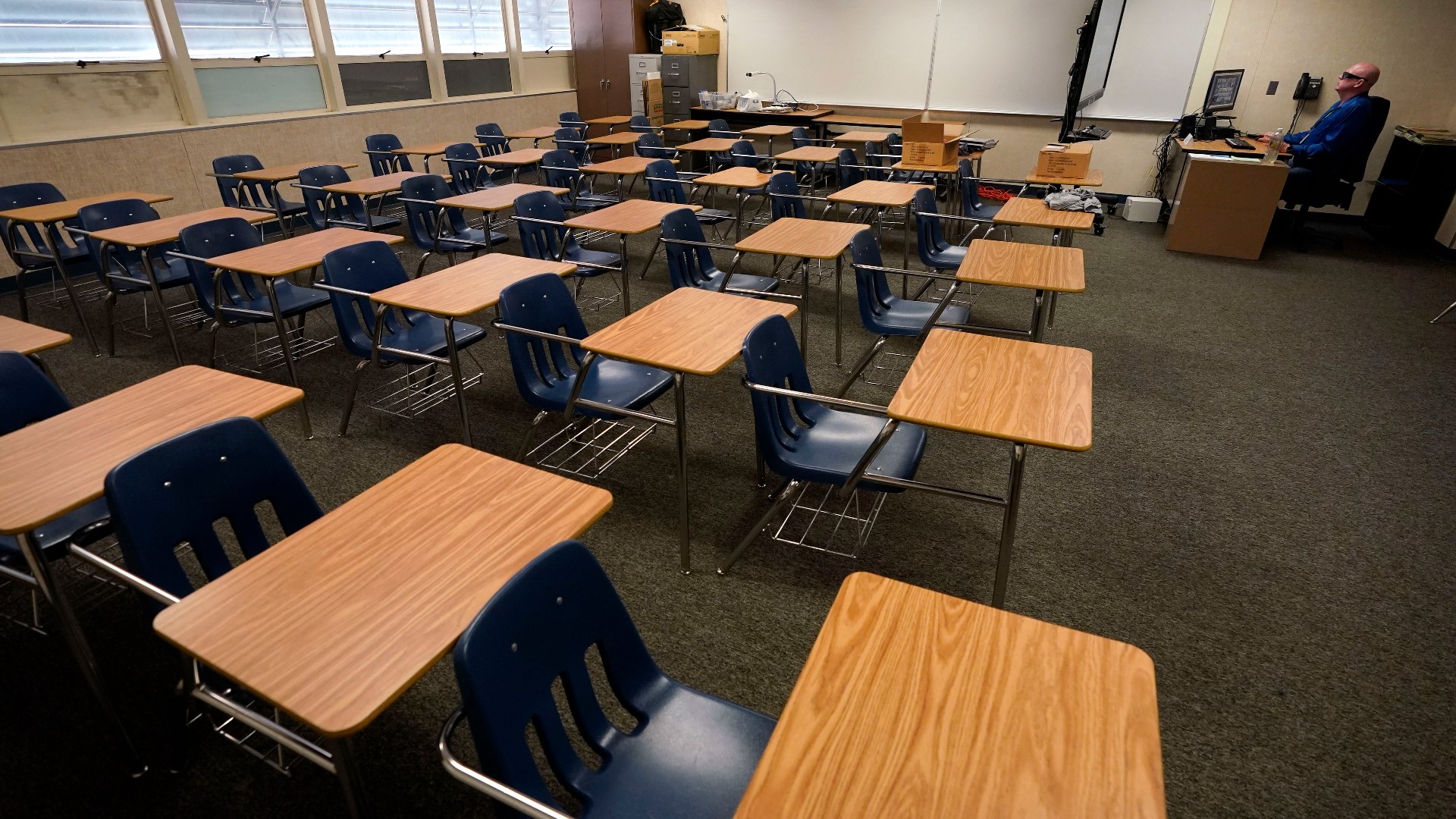CALIFORNIA, USA — A majority of California’s largest school districts plan on bringing students and teachers back on campuses by early April, even as local officials grapple with state social distancing requirements they say are unclear and limit kids’ in-person options.
Rapidly declining case rates and teacher vaccinations have drastically changed California’s reopening landscape after a year of most K-12 campuses staying closed. Gov. Gavin Newsom said Tuesday that 9,000 of the state’s schools — an “overwhelming majority” — are either open for some in-person instruction or will be by next month. As of Tuesday, 88% of Californians lived in counties that now allow in-person instruction for middle and high school students.
But whether the state’s schools will expand to offer full-time in-person instruction this spring or in the fall will largely depend on state distancing requirements that school officials say effectively prevents most schools from operating full-time in-person schedules, particularly for middle and high school grades.
Spacing requirements
California’s rules for reopening, updated in late January, allow schools to physically reopen if they follow strict safety measures, which includes spacing desks no less than four feet while making a “good-faith effort” to maintain six feet of spacing. Recent studies have suggested schools can safely operate with three feet of distancing versus six feet. The Centers for Disease Control recommended six feet of distance in its latest February guidance, but doesn’t set a minimum standard. The CDC said this week that it would reconsider easing its spacing guidance.
Now, health experts, parents and administrators want California to clarify its distancing requirements for reopening campuses.
“Six feet (of distancing) is not difficult for a hybrid model,” said John Malloy, superintendent of the San Ramon Valley Unified School District. “But we don’t think the hybrid model, where kids are only on campus half the time, is conducive for everyone. We want our kids in school full time, five days a week.”
The Contra Costa County school district brought middle and high school students back on campus Wednesday under a hybrid model — similar to how most other California schools have so far physically reopened. In a March 11 letter to the governor pleading for clarification on state guidance, the San Ramon Valley school board said it wants to be able to offer students and families full-time in-person instruction this fall, noting that distancing “is the most critical factor when determining what school will look like in the fall.”
“We desperately need clear and consistent communication and guidelines from the state,” the school board wrote to Newsom.
Speaking at an elementary school in Alameda, Newsom said the state would revisit its own rules for reopening schools based on whether the CDC updates its guidance while touting the state’s progress in reopening schools.
“We look forward to working through that in real time once we have more clarity from the feds,” Newsom told reporters.
Parents sue
Last month, parent advocates in San Diego County sued the state in an attempt to undo school-reopening rules they argued has arbitrarily kept schools from offering full-time in-person instruction. A judge issued a temporary restraining order Monday.
“(The judge) essentially indicted remote learning as a failed learning model and slammed the state for creating rules that arbitrarily forced some students into remote learning while allowing others to attend in-person,” said Scott Davison, co-director of the Parent Association of Carlsbad and a supporter of the suit.
Tustin Unified in Orange County began offering in-person instruction via hybrid scheduling for all grades starting last September and has not experienced any cases of in-school transmission, according to Gregory A. Franklin, Tustin’s superintendent. Six in 10 students are attending school in person in Tustin, with most campuses operating at 30% capacity.
Teachers are instructing students who opted to remain online while also directing the students in their physical classrooms. Engaging students under hybrid instruction remains a challenge, Franklin said, because “it’s much easier for a kid to struggle anonymously online,” without continuous interactions with educators.
When the 2021-22 school year begins, Franklin envisions schools will continue operating with many of the same measures — everyone wears masks, washes their hands, travels hallways in one direction. Unclear yet is whether the rules will allow for a full-time return.
“What’s a little frustrating is when we talk to the health officials, they talk about doing distance as much as practicable but not less than 4 (feet),” Franklin said. “We have yet to talk to a health official who’s able to explain why 4 feet is different than 3 feet. I’m not sure how much science is involved in those decisions about the distancing.”
What’s next
The Legislature will decide this spring to what extent it will allow school districts to operate under hybrid and distance learning next school year, but schools are anxious for guidance on spacing; some year-round schools begin their terms in July.
“Physical distancing is a huge barrier to reopening schools for full five-day-a-week schedules,” said Dr. Jeanne Noble, director of COVID-19 response for UC San Francisco’s emergency department.
“So it’s really time to look closely at the data and say is it necessary, because it’s going to keep millions of kids out of full time school. The data tells us it’s not necessary, that masking is really the key to this.”
Watch more from ABC10:
California COVID rent relief program starts taking applications | Dollars and Sense

